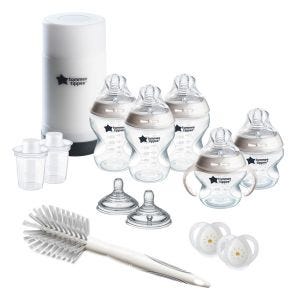
This is a demo store. No orders will be fulfilled.
Subscription orders can be cancelled at anytime. Free delivery on all subsequent subscription orders. Find out more about subscriptions.
They’re easy and fuss free
Your products are automatically sent to you
You save up to 10% when you sign up for a subscription
You can cancel at any time
If you're getting ready for your little one's big arrival and preparing to breastfeed, you've probably heard whispers of 'the first latch' or 'latching on'.
But you may not know exactly what a good breastfeeding latch is, or how to achieve it - after all, you're new to all this!
So, let's demystify this breastfeeding lingo, and run you through everything you need to know about latching on while breastfeeding.
Latching on is the process of getting your little one to suckle around your nipple and areola so they can breastfeed comfortably.
If your baby is latched on properly, breastfeeding shouldn't cause you pain and your nipples won't become cracked or painful.
Think of your areola as a target for your baby's mouth and try to get them right in the bullseye! They should press against this target to trigger the flow of your milk and establish a good breast milk supply.
Getting the hang of a good breastfeeding latch that's comfortable for you both can be tricky at first. It can take time and perseverance to get it all going smoothly!
Don't stress, we're here to talk you through how to get a good latch with some of our top breastfeeding latching tips:
If you think your baby isn't latched correctly or if your nipples hurt while nursing, you can slide your finger into their mouth to break the hold they have on your breast. You can then try again and alter your position to achieve a better latch that's more comfortable.
Don't forget, it's not supposed to be painful. You and your baby should be comfortable, and you should be able to see them sucking, swallowing, and breathing.
Getting the hang of a good breastfeeding latch that's comfortable for you both can be tricky at first. It can take time and perseverance to get it all going smoothly!
There are some signs to look out for that will let you know if your baby is latched on properly:
Getting a latch for bigger boobs can be more difficult so it's important to get into the right position.
Getting a good breastfeeding latch should become easier with time, but if you're finding it hard, try giving these breastfeeding latch tricks and tips a try:
If these tips don't help and you're still struggling to achieve a good latch or are concerned that your baby may be tongue-tied, consult your doctor or health visitor for advice.
We know that parents can be very busy and getting a good breastfeeding latch can be a tricky process that can cause extra stress. To help simplify the process, here's a quick list of things to check for when breastfeeding which indicate a good breastfeeding latch:
If you're struggling at all, don't be afraid to ask for help. You can get in touch with your midwife or lactation specialist, and they'll be able to help you out with any breastfeeding-related issues.
A shallow latch is when a baby isn't opening their mouth wide enough to nurse without causing you any pain. If you're experiencing a shallow latch:
Although breastfeeding in public is nothing to be ashamed of, some parents may want to feed discreetly when they're out and about.
If you do want to breastfeed discreetly - for whatever reason - wearing a loose-fitting, or specially designed breastfeeding shirt or shawl can help you and your baby achieve a good latch without exposing too much of your breast.